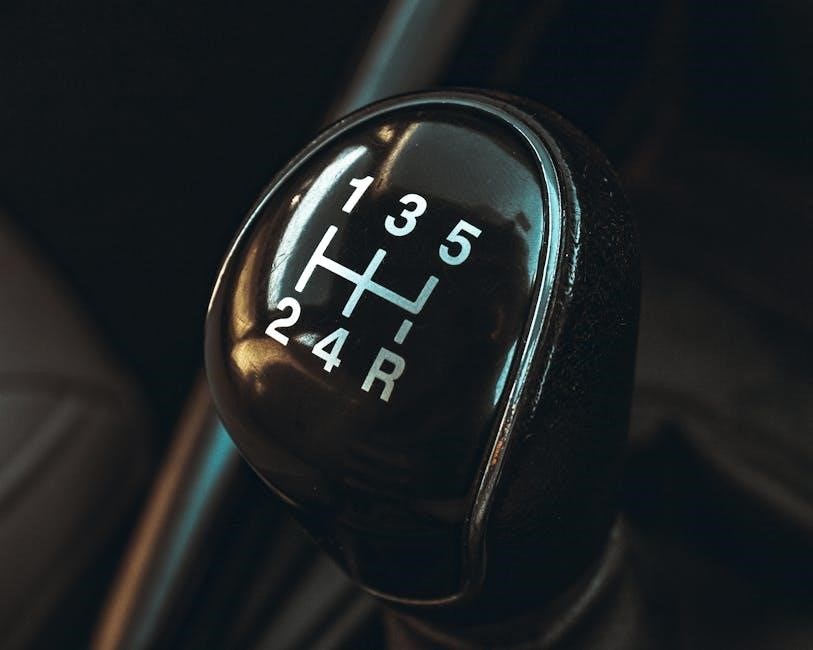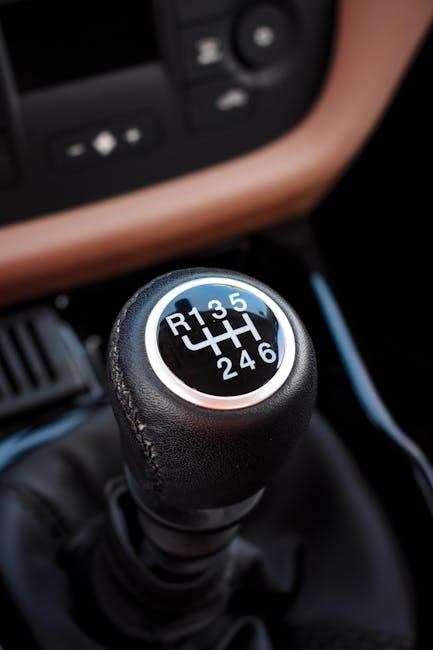Removing the manual transmission from a 1997 Camaro SS is a complex process requiring careful preparation and specialized tools․ This guide provides a detailed, step-by-step walkthrough to help you successfully complete the job in your home garage, ensuring safety and efficiency throughout the procedure․
Overview of the Process
Removing the manual transmission from a 1997 Camaro SS involves a series of meticulous steps, including lifting the vehicle, draining fluid, and disconnecting components like the driveshaft and gear shifter․ The process requires specialized tools, such as a swivel socket, and a well-equipped garage setup․ While challenging, the procedure is manageable with patience and proper planning․ Key phases include disconnecting electrical connectors, removing transmission mounts, and carefully lowering the unit․ Safety and organization are crucial to avoid damage and ensure a smooth reinstallation or replacement process․

Tools and Equipment Needed
Essential tools include a transmission jack, wrenches, screwdrivers, a 9/16 swivel socket, extensions, a drain pan, and jack stands to safely remove the manual transmission․
Essential Tools
The essential tools for removing the manual transmission include a 9/16 swivel socket and a 2-foot extension in 3/8 drive, which simplifies accessing difficult top bolts․ A transmission jack is crucial for safely lowering the unit․ Additionally, a set of wrenches and screwdrivers are necessary for disconnecting components․ A drain pan is required for capturing transmission fluid, and jack stands ensure the vehicle remains stable during the process․ These tools are fundamental for a successful and safe transmission removal․
Recommended Tools
Recommended tools for a smoother process include a ball-peen hammer for loosening stubborn components and a set of pry bars for gently dislodging parts․ A transmission jack with a tilting feature enhances control during removal․ Penetrating oil can help free stuck bolts, while a universal joint tool aids in disconnecting the driveshaft․ A gear puller is useful for removing bearings or other tightly fitted components․ These tools, though not essential, significantly simplify the process and reduce the risk of damage to surrounding parts․
Preparation Steps
Proper preparation ensures a smooth transmission removal process․ Lift the vehicle, drain the fluid, and remove components blocking access․ Secure the car on jack stands for stability․
Lifting the Vehicle
Lifting the 1997 Camaro SS safely is essential for transmission removal․ Place the car on a level surface and use a hydraulic jack to raise it․ Ensure the vehicle is securely supported by jack stands positioned under the frame rails for stability․ Raise the car high enough to access the underside comfortably․ Always follow proper lifting techniques to avoid damage or injury․ Ensure the parking brake is engaged and wheels are chocked for added safety during the process․
Draining Transmission Fluid
Draining the transmission fluid is a critical step before removal․ Locate the transmission pan, usually found near the front of the transmission․ Use a drain pan to catch the fluid as you remove the bolts․ Start with the lower bolts and work your way around to avoid spills․ Be cautious, as the fluid may still be hot․ Allow the fluid to drain completely before proceeding․ This step ensures a cleaner workspace and prevents fluid leaks during the removal process․ Proper disposal of the used fluid is recommended․
Removing the Driveshaft
Removing the driveshaft is essential to access the transmission․ Start by marking the driveshaft and differential flange for proper realignment later․ Use a wrench to loosen the bolts on the center bearing bracket․ Once loose, carefully pull the driveshaft out of the transmission․ Be cautious, as the shaft may be heavy and cumbersome․ Support the driveshaft with a jack or rope to prevent damage or injury․ This step ensures clear access to the transmission mounts and crossmember for removal․ Proper handling is crucial to avoid damaging the driveshaft or surrounding components․
Component Disconnection
Disconnecting key components like the gear shifter, clutch slave cylinder, and electrical connectors is crucial for transmission removal․ Ensure all lines and linkages are carefully detached to avoid damage․
Disconnecting the Gear Shifter
To disconnect the gear shifter, start by removing the shift knob and boot․ Next, remove the shifter bolt from the transmission tunnel․ Use a wrench or socket to loosen and remove the bolt securing the shifter to the transmission․ Gently pull the shifter free from the transmission shaft․ Be careful not to damage the surrounding components or the shifter itself․ This step provides access to the transmission for further disconnection and removal․ Ensure all linkages are fully detached before proceeding․
Removing the Clutch Slave Cylinder
Start by disconnecting the hydraulic line from the clutch slave cylinder using a wrench or pliers․ Place rags nearby to catch any fluid spills․ Remove the mounting bolts securing the cylinder to the transmission using a socket or wrench․ Gently pull the slave cylinder away from the transmission, taking care not to damage the hydraulic line or surrounding components․ Ensure all fluid is drained and components are protected before proceeding․ This step is crucial for accessing the transmission and clutch assembly․ Proper preparation and caution are essential to avoid damage and ensure a smooth process․
Intake Manifold Removal
Removing the intake manifold is essential for accessing the top transmission bolts․ Start by disconnecting the throttle body, fuel injectors, and vacuum hoses using a Torx screwdriver․ Remove the manifold bolts with a socket wrench, working from the center outward to avoid warping the manifold․ Gently lift the manifold and set it aside, taking care not to damage electrical connectors or fuel lines․ This step provides clear access to the transmission’s upper mounting points, simplifying the removal process․ Proper handling ensures no damage to sensitive engine components․
Disconnecting Electrical Connectors and Lines
Disconnecting electrical connectors and lines is crucial to avoid damage during transmission removal․ Start by locating the connectors attached to the transmission, such as the reverse light switch and speedometer․ Use a Torx screwdriver to release the connectors from their mounts․ Gently pull the connectors away from the transmission, ensuring no wires are stretched or damaged․ For hydraulic lines connected to the clutch slave cylinder, use a wrench to loosen the fittings and carefully drain the fluid into a pan․ Secure the lines to prevent fluid loss․ Label all connectors for easy reconnection later․ This step ensures safe and organized removal of the transmission․

Transmission Mounts and Crossmember
Removing the transmission mounts and crossmember is essential for accessing the transmission․ Use a wrench to bolt them and carefully lower the crossmember away from the transmission․
Removing Transmission Mounts
Start by supporting the transmission with a jack to prevent it from falling․ Locate the transmission mounts, which secure the transmission to the crossmember․ Use a wrench or socket to remove the bolts holding the mounts in place․ Gently pry the mounts away from the transmission, taking care not to damage the surrounding components․ If the bolts are stuck, apply penetrating oil to loosen them․ Once the mounts are removed, the transmission will have more flexibility for the removal process․ Proper support is crucial to ensure safety and avoid damage to the vehicle․
Removing the Crossmember
To remove the crossmember, start by locating and removing the bolts that secure it to the chassis․ Use a wrench or socket, typically 15mm or 18mm, to remove these bolts․ After removing the bolts, gently wiggle the crossmember to free it from its position․ Be cautious to avoid damaging nearby components or the vehicle’s underside․ Once loose, carefully lift the crossmember away․ This step provides additional clearance for transmission removal․ Ensure the transmission is properly supported with a jack to maintain safety and prevent potential damage during the process․
Lowering the Transmission
Use a transmission jack to slowly lower the unit, maintaining stability․ Ensure the transmission remains secure and balanced throughout the process to avoid damage or injury․
Supporting the Transmission
Securely support the transmission using a sturdy transmission jack or a hydraulic lift․ Ensure the unit is evenly balanced and tightly strapped to prevent shifting or damage․ Use additional jack stands for added safety and stability during the removal process․ Proper support is crucial to avoid injury and component damage․ Always maintain steady control while lowering or maneuvering the transmission assembly․ This step requires patience and careful coordination to ensure a smooth operation․ Safety straps or chains can provide extra security, especially when dealing with heavy components․ Monitor the transmission’s position closely throughout the process․
Prying the Transmission Loose
Locate the pry bar position at the top of the bell housing where it meets the engine block․ Gently pry the transmission loose while ensuring it remains supported by a jack or transmission lift․ Avoid applying too much force, which could damage the housing or engine․ If stuck, carefully tap with a hammer around the mating surface to break any corrosion or debris․ Maintain steady control throughout the process to prevent sudden movements․ This step requires patience and precision to safely separate the transmission without causing damage․ Proper leverage and careful prying are key to success․
Transmission Removal
With the transmission supported, carefully pry it loose using a jack and pry bar, ensuring it remains stable․ Avoid excessive force to prevent damage․
Dropping the Transmission
Dropping the transmission requires careful maneuvering to avoid damaging the vehicle or surrounding components․ With the transmission fully supported by a jack and jack stands, slowly lower it while ensuring stability․ Be cautious of the transmission tunnel and nearby parts as you guide it down․ Once clear of the vehicle, carefully roll the transmission away on a dolly or cart, ensuring the area is clear of obstacles․ This step is critical and demands precision to prevent accidents or damage․
Inspecting and Replacing Components
After removing the transmission, inspect all components for wear or damage․ Check the clutch, throwout bearing, and pilot bearing, replacing them if necessary․ Examine the input shaft seal for leaks and replace it if damaged․ Inspect the transmission mounts and crossmember for any signs of wear․ Replace any damaged or corroded components to ensure proper function and prevent future issues․ Use OEM or high-quality aftermarket parts for reliability․ Consult a service manual for specific replacement guidelines and torque specifications to ensure accuracy during reinstallation․

Troubleshooting Common Issues
Stuck bolts and components are common challenges․ Use a 9/16 swivel socket and 2ft extension for difficult bolts․ Ensure proper transmission support to avoid damage during removal․
Stuck Bolts and Components
Stuck bolts and components are common issues during transmission removal․ Use a 9/16 swivel socket and 2ft extension for hard-to-reach bolts․ Apply penetrating oil and heat to loosen corroded parts․ Avoid forcing bolts, as this can damage threads or surrounding components․ If bolts remain stubborn, consider professional assistance or specialized tools․ Proper tools and techniques can save time and prevent further damage․ Patience and careful application of force are key to overcoming these challenges during the removal process․
Additional Resources and Information
Consult Chevrolet service manuals or online forums for detailed guides and troubleshooting tips․ Technical diagrams and videos can provide visual assistance for complex steps, ensuring accuracy and safety․
Service Manuals and Technical Guides
Dealership service manuals for the 1997 Camaro SS provide detailed instructions and diagrams for transmission removal․ These manuals cover essential procedures, torque specifications, and component locations․ Technical guides from Chevrolet or aftermarket sources, such as those for the LT-1 engine and T56 transmission, offer step-by-step instructions․ Additionally, online forums and communities, like Camaro5, share real-world experiences and tips from experienced mechanics․ These resources are invaluable for ensuring accuracy and safety during the removal process, especially for accessing hard-to-reach components like the top transmission bolts․
Time Management
Removing the manual transmission from a 1997 Camaro SS is a time-consuming process, requiring a minimum of 8-12 hours for experienced mechanics․ Novices should allocate 16-20 hours, considering potential challenges like stuck bolts or accessing hidden components․ Planning is crucial; gather all tools and materials beforehand to avoid delays․ Breaking the task into smaller steps, such as preparation, component disconnection, and transmission removal, helps manage time effectively․ Allocating extra time for unexpected issues ensures the job is done safely and efficiently without rushing․
Seeking Assistance
Seeking assistance is crucial when removing the manual transmission from a 1997 Camaro SS․ Consult service manuals or online forums like Camaro5 for detailed guidance․ If inexperienced, consider enlisting a professional to avoid costly mistakes․ Joining enthusiast communities can provide valuable support and tips․ Additionally, specialized tools like a 9/16 swivel socket can simplify difficult tasks․ Common issues like stuck bolts can be tackled with the right advice․ Don’t hesitate to reach out for help to ensure the job is done safely and efficiently․

Post-Removal Procedures
After removing the transmission, bleed the clutch system to eliminate air bubbles and ensure proper engagement․ Refill the transmission fluid to the recommended level and inspect for leaks․
Bleeding the Clutch System
Bleeding the clutch system is crucial after transmission removal to ensure proper function․ Start by filling the clutch master cylinder with fresh brake fluid․ Use a bleed kit to purge air from the system․ Attach the kit to the slave cylinder and gently press the clutch pedal several times․ Repeat until fluid flows freely without bubbles; If resistance remains, additional purging may be needed․ Always refer to a service manual for specific instructions tailored to your 1997 Camaro SS․
Refilling Transmission Fluid
After transmission removal, refilling the fluid is essential for proper operation․ Use a high-quality ATF+3 or equivalent fluid․ Locate the transmission pan and use a pump or funnel to fill it to the recommended level․ Refer to your service manual for specific fluid capacity and type․ Ensure the system is clean and free of debris before refilling․ Double-check the fluid level with the car on level ground and test the transmission for smooth operation․ Proper fluid levels prevent damage and ensure optimal performance in your 1997 Camaro SS․
Removing the manual transmission from your 1997 Camaro SS requires effort and patience, but with proper tools and preparation, it’s a manageable DIY project yielding great satisfaction․
Final Tips
Ensure you have a 9/16 swivel socket and 2ft extension for accessing top bolts․ Label all electrical connectors before disconnection․ Work methodically and avoid rushing․ Always refer to service manuals or online forums for specific guidance․ If unsure, consult a professional․ Properly support the transmission during removal to prevent damage․ Keep all bolts and components organized for reinstallation․ Bleed the clutch system thoroughly after reinstalling the transmission․ Regularly check fluid levels and inspect for leaks post-replacement․ Remember, patience and careful planning are key to a successful transmission removal and reinstallation process․